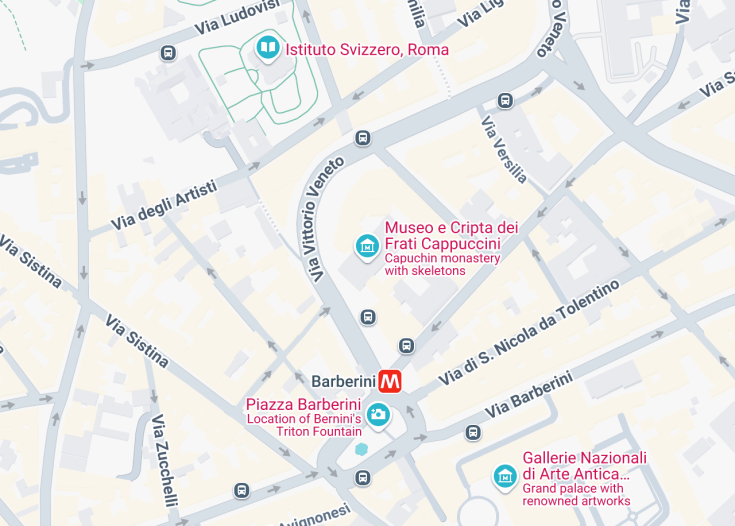The Capuchin Crypt, located in the heart of Rome, Italy, is a remarkable site steeped in history and artistry. This ossuary, beneath the Church of Santa Maria della Concezione dei Cappuccini, features the bones of over 4,000 Capuchin friars, arranged in intricate patterns, offering a profound reflection on mortality and faith. Its unique blend of art and spirituality renders the Capuchin Crypt a captivating, yet somber destination for visitors seeking deeper understanding of the human experience.
When visiting the Capuchin Crypt, consider booking your tickets in advance to avoid long queues. The place attracts numerous visitors daily, and securing a time slot will enhance your experience and allow you to absorb the atmosphere without rush.
For an enriching experience, take time to explore the adjoining museum, which houses historic artifacts related to the Capuchin order. This complements the crypt visit, as it provides insights into the lives of the friars and their legacy in Rome.
Capuchin Crypt: A Chilling Journey Through Time
The Capuchin Crypt, nestled in the heart of Rome, Italy, is a remarkable underground burial site that piques the curiosity of many visitors. Constructed between 1626 and 1631, this hauntingly beautiful crypt is adorned with the skeletal remains of over 4,000 Capuchin friars. It serves not only as a burial ground but also as a profound statement on mortality and the transient nature of life. In the crypt, visitors encounter intricate decorations made entirely from bones, including skulls, femurs, and other skeletal parts arranged in artistic patterns. This chilling artistry compels many to reflect on the themes of life and death. The Capuchin Crypt is located beneath the Church of Santa Maria della Concezione dei Cappuccini, making it accessible to those exploring Roman history. With its somber yet captivating atmosphere, this site captures the imagination, drawing both tourists and scholars alike who are eager to delve into the unique blend of spirituality and artistry found within these hallowed halls.
Discover the Unique Artistry of the Crypt
As you explore the Capuchin Crypt, you will find five distinct chapels, each adorned with different bone arrangements that tell a story of faith and death.
The Crypt of the Skulls
Here, the skulls of friars are thoughtfully displayed, arranged to form elegant patterns that invite contemplation.
The Mass Chapel
This area showcases a striking altar made from bones, symbolizing the ultimate sacrifice and connection to the divine.
Bone Gallery
In this gallery, entire walls are lined with human skeletal remains, ingeniously crafted into an artistic testament of the passage of time and the inevitability of death. Visitors often leave with a sense of reverence, having witnessed firsthand the unique confluence of art, history, and spirituality that the Capuchin Crypt offers.
A Remarkable Fact About the Capuchin Crypt
One of the most interesting aspects of the Capuchin Crypt is its underlying message: “What you are now, we once were; what we are now, you will be.” This poignant reminder, inscribed on one of the walls, invites visitors to confront their mortality and consider the transient nature of life. The friars intended the crypt to serve as a reminder for their community and anyone who enters, emphasizing the importance of humility and reflection. This unsettling yet thought-provoking philosophy resonates deeply with those who visit, enhancing the crypt’s historical significance and emotional impact.
Explore the Enigmatic Capuchin Crypt in Rome, Italy!
The Capuchin Crypt, located beneath the Church of Santa Maria della Concezione dei Cappuccini, is a fascinating yet haunting attraction that draws visitors seeking a unique historical and cultural experience. This crypt, decorated with the skeletal remains of over 4,000 Capuchin monks, serves as a striking reminder of the transient nature of life. It is ideal for those with an interest in history, art, and the macabre or for anyone looking to explore a different facet of Rome beyond its famous tourist spots.
Upon entering the crypt, visitors are greeted by an atmosphere that is both somber and reflective. The bones are skillfully arranged into intricate designs, including chandeliers and wall decorations, each telling a story of faith and mortality. Expect to be mesmerized by the peculiar beauty of this site as it offers a profound commentary on life and death.
The Capuchin Crypt is an essential stop on a broader tourist itinerary in Rome, easily paired with visits to other nearby attractions, such as the Trevi Fountain and the Spanish Steps. A stroll through these iconic landmarks can create a rich day filled with culture and history.
Unique Tip: If you’re particularly sensitive to the theme of death, it might be wise to mentally prepare yourself before visiting. Arrive early to not only avoid the crowds but also to have a more intimate experience in this reflective space.
What is the Best Time to Visit the Capuchin Crypt in Rome, Italy?
To experience the Capuchin Crypt at its best, it is recommended to visit during weekday mornings. This is generally when the crowds are thinner, allowing for a more personal experience. Furthermore, the light filtering through the crypt’s openings creates an ethereal ambiance, making your visit all the more memorable.
Recurring Events and Special Occasions
A special time to visit the Capuchin Crypt is during All Saints’ Day on November 1st, when many locals pay homage to the monks buried within. This occasion may also feature unique commemorative services that enhance the experience for visitors intrigued by the reverence surrounding this historical site.
Accessibility and Limitations
While the Capuchin Crypt is an intriguing site, there are some limitations to consider when planning your visit.
Accessibility
Limitations
- Photography is prohibited inside the crypt to preserve its solemnity.
- Visitors are required to dress modestly; shorts and sleeveless tops are not allowed.
- Large bags and backpacks must be checked at the entrance.
Notes to visitors
- Expect a solemn atmosphere; maintain a respectful demeanor while touring.
- Guided tours may provide enhanced insights into the history and significance of the crypt.
General Information about the Capuchin Crypt
Details for your visit to the Capuchin Crypt include essential tips for enjoying this unique attraction.
Location
The Capuchin Crypt is conveniently situated near several popular landmarks, making it easy to include in your Roman adventure.
Address:
Via Vittorio Veneto, 27, 00187 Roma RM, ItalyVisiting Information
The Capuchin Crypt is open to the public daily, with specific visiting hours that can vary. It is recommended to visit early in the day for a calmer experience, as it can become crowded, especially on weekends.
How to Reach the Capuchin Crypt
Reaching the Capuchin Crypt from the city center is straightforward, with multiple transportation options available.
Car
The Capuchin Crypt can be easily reached by car, with nearby parking facilities available at a nominal fee.
| Route | Distance | Travel time |
|---|---|---|
| From Termini Station | 1.5 miles (2.4 km) | 10 minutes |
| From Piazza Navona | 1.2 miles (2 km) | 15 minutes |
| From Vatican City | 2.5 miles (4 km) | 15 minutes |
Public Transport
The area is well-served by Rome’s public transportation network, making it accessible via bus and metro systems.
| Route | Distance | Travel time |
|---|---|---|
| From Termini Station (Metro Line A) | 1 mile (1.6 km) | 5 minutes |
| From Piazza Navona (Bus 81) | 1 mile (1.6 km) | 10 minutes |
| From Vatican City (Bus 19) | 1.5 miles (2.4 km) | 15 minutes |
Nearby Attractions
- Trevi Fountain – 1 mile (1.6 km)
- The Spanish Steps – 1.1 miles (1.8 km)
- Villa Borghese – 1.2 miles (1.9 km)
- Piazza Barberini – 0.6 miles (1 km)
- Quirinal Palace – 0.7 miles (1.1 km)
- Roman Forum – 1.3 miles (2.1 km)
- Colosseum – 1.5 miles (2.4 km)
- Palatine Hill – 1.5 miles (2.5 km)
- Pantheon – 1 mile (1.6 km)
- Campo de’ Fiori – 1.2 miles (2 km)
- Galleria Doria Pamphilj – 0.8 miles (1.3 km)
- Church of Santa Maria della Concezione dei Cappuccini – 0 miles (0 km)
Common Questions
What is the Capuchin Crypt and why is it famous?
What is the history behind the Capuchin Crypt?
What can visitors expect to see inside the Capuchin Crypt?
- The Ossuary: This central area contains the skeletal remains of over 4,000 friars, meticulously arranged to create stunning designs.
- Decorative Bone Art: Visitors will see different art forms, including chandeliers, wall decorations, and even the Capuchin coat of arms, all composed of bones.
- Morality Exhibits: Inscriptions and carvings serve as reminders of the fragility of life and the inevitability of death, with phrases encouraging reflection on one’s existence.
Each room tells a story and conveys the Capuchin perspective on mortality, emphasizing humility and remembrance. Although the crypt may have a somber tone, it is also a place of profound beauty and contemplation, offering visitors a unique glimpse into the rituals and beliefs of the Capuchin monks. Overall, the Capuchin Crypt presents an unforgettable experience that blends art, history, and spirituality.
Are there any rules or etiquette to observe while visiting the Capuchin Crypt?
- Silence and Respect: The crypt is a sacred place that encourages reflection on mortality. Maintaining a quiet demeanor is paramount, as loud conversations can disrupt the solemn atmosphere.
- No Photography: Taking pictures inside the crypt is not allowed as a sign of respect for the dead. Visitors are encouraged to enjoy the experience visually and mentally rather than through a camera lens.
- Appropriate Dress: As it is a religious site, it is important to dress modestly. Visitors should cover their shoulders and knees to show respect for the sanctity of the site.
- Time Limits: To ensure everyone has the opportunity to view the exhibits, visitors may be asked to keep their visit to a reasonable time frame.
By adhering to these guidelines, visitors can appreciate the Capuchin Crypt’s extraordinary artistry and meaning while fostering an atmosphere of solemnity and reflection that is fitting for such a unique site.
What is the significance of the art in the Capuchin Crypt?
- Mortality Reminder: The crypt’s elaborate use of bones serves as a constant reminder to visitors about the inevitability of death. The Capuchin friars aimed to encourage reflection on one’s life choices.
- Spiritual Reflection: Through artistic display, the crypt provides a space for contemplation and prayer. The art evokes a deep sense of spirituality and urges individuals to reconnect with their faith and life’s true importance.
- Cultural Heritage: The artistry represents a unique blend of the Baroque period’s artistic style and the Capuchin Order’s austere principles. The crypt serves as a valuable historical artifact that reflects the culture of the time.
Overall, the art in the Capuchin Crypt transcends mere decoration; it offers significant insights into the beliefs, values, and artistic sensibilities of the Capuchin Order, making it not just a burial site but a poignant reflection on existence itself.

Is the Capuchin Crypt in Rome, Italy Worth Visiting?
The Capuchin Crypt in Rome, Italy, presents a truly unique experience that draws many tourists each year. This underground burial site, adorned with the bones of over 4,000 Capuchin monks, serves as a fascinating blend of art, history, and spirituality.
Visitors are often struck by the intricate designs created from human bones, making it an incredibly thought-provoking place that challenges perceptions about mortality and the afterlife.
While some may find the crypt’s atmosphere unsettling, for those interested in history, art, or religious studies, it can prove to be a profoundly moving experience. However, it is essential to approach this site with respect and an understanding of its somber significance.
Ultimately, the Capuchin Crypt is worth a visit for those looking to explore a less conventional aspect of Rome’s rich cultural tapestry.









